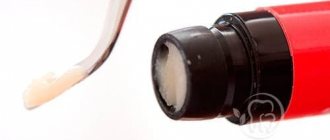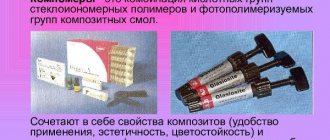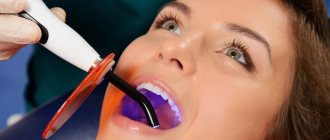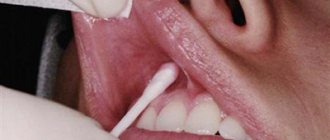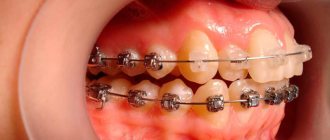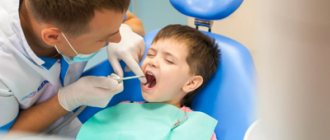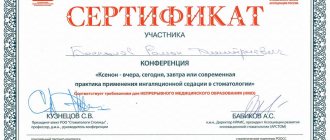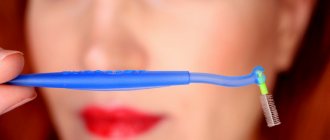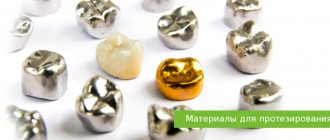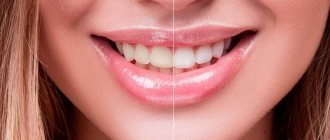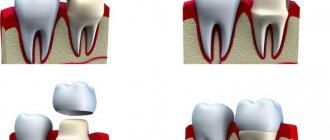3232
Filling materials for teeth are selected not only taking into account the degree and nature of the carious process, the condition of the pulp and the group of the tooth, but also the age of the patient.
It is quite clear that taking into account the low immunity, the high sensitivity of the child’s body to external and internal factors, as well as the structural features of the milk units, filling materials for children should be selected with special care.
Requirements
The human dentofacial apparatus operates under extremely difficult conditions. To successfully perform their functions, sealing compounds must comply with a number of technological and operational conditions.
Primary requirements:
- Must be chemically inert, biocompatible with periodontal tissues and the oral mucosa. Have a pH close to 7.
- Do not dissolve in oral fluid, absorb minimal water from it.
- Have sufficient working time (the period from the end of mixing the components or other preparation of the filling composition until the completion of manipulations in the patient’s mouth).
- Possess high adhesive strength (adhesion) in a humid environment.
- Have thermal expansion close to the tooth tissues.
- Cure for a specific time as required.
- Maintain a color that closely imitates natural elements.
- Have low shrinkage to ensure good marginal seal of the filling.
- Have a hardness commensurate with the hardness of enamel.
- Be abrasion resistant.
- Do not show abrasive properties in relation to antagonist teeth.
- Possess anti-inflammatory and antiseptic properties.
Features of filling baby teeth in children
Modern pediatric dentistry has a variety of tools, equipment and materials that make fillings high-quality and long-lasting. The most commonly used is composite. This material has the property of self-hardening. A composite complex with glass ionomer cement is also used. This filling material adheres well to the surrounding tooth tissues, is resistant to external factors, and lends itself well to working with tools.
Types of cements
Dental cements and other filling compounds are used in the treatment of permanent and primary teeth in the form of fillings, linings, obturation materials and sealants.
They are classified according to their basis, and can be of the following types:
- Mineral cements. They are made on the basis of phosphoric acid, which is why they are called “phosphates”. These include zinc phosphate, silicate and silicophosphate compounds.
- Polymer cements. They use organic acid as a base, usually polyacrylic acid. This group includes polycarboxylate and glass ionomer cements.
- Oil-based formulations. The main material of this group is zinc oxide-eugenol cement.
- Water-based materials (water-based dentin).
Phosphates
They include three main types of materials: zinc phosphate, silicate and silicophosphate cements.
Zinc phosphate consists of two components - powder (a mixture of Zn oxides (75-90%), Si, Ca, Al, F, Mg) and liquid (orthophosphoric acid).
Advantages of zinc phosphate composition:
- Harmless to the pulp.
- Good adhesion to fabrics.
- Low thermal conductivity.
- Radiopacity.
Flaws:
- low strength;
- large shrinkage during curing;
- instability to saliva;
- difference in color from natural fabrics.
Silicate cements. The powder is a carefully ground aluminosilicate glass (oxides of Si, Ca, Al, F). The liquid, like all fluorides, is phosphoric acid.
Currently, this type of material is rarely used. In no small part due to the irritating effect on the pulp, which is especially important for children's teeth. There are other disadvantages as well.
Silicophosphate cements. A mixture of both zinc phosphate (40%) and silicate (60%) cements. They surpass silicate cements in strength parameters.
Positive properties:
- non-toxic to pulp;
- good adhesion;
- sufficient strength.
Flaws:
- solubility in saliva;
- bad aesthetics.
For the treatment of baby teeth, the brands “Infantid”, “Lactodont”, “Beladont” are mainly used.
For moderate and superficial caries, due to the low toxicity of silicophosphate cements to the pulp, insulating spacers do not need to be used.
At what age should you start caries prevention in children and what measures are taken.
Visit here to learn more about the indications for photodynamic therapy in dentistry.
At this address https://zubovv.ru/lechenie/zubyi/chasto-diagnostiruemyie-patologii.html we will consider commonly diagnosed dental pathologies in children.
Phenolates
This class of materials includes Ca(OH)2-salicylate (chelate) and zinc-eugenol cements. The latter consist of zinc oxide and eugenol, which react upon curing to produce zinc eugenolate.
Eugenol (clove oil) – found in the aerial parts of the eugenia plant, has bactericidal, antiseptic and analgesic properties.
The main advantage of zinc-eugenol cements is their anti-inflammatory and odontotropic (dentin-forming) properties.
Flaws:
- low mechanical strength;
- high solubility in oral fluid;
- incompatibility with composites;
- pulp irritation (potential allergen).
Calcium hydroxide cements consist of two pastes. The first includes Ca(OH)2, the second contains substances that provide hardening. Their advantages include:
- beneficial effect on the pulp (it can be coated without a gasket);
- ease of preparation and use;
- fast curing.
Flaws:
- low hardness;
- solubility in case of seal failure.
Phenolates can be used to treat primary teeth. However, interest in them among pediatric dentists has disappeared due to the emergence of new, better materials.
Polycarboxylates
Polycarboxylate cements are intermediate between mineral and composite. Manufactured on the basis of polyacrylic acid. They consist of powder (specially processed zinc oxide with the addition of calcium and magnesium salts) and a binding liquid – polyacrylic acid.
Positive properties:
- low toxicity to the pulp , due to which no gasket is required when filling mammary units;
- good adhesion (chemical bond with dentin and enamel);
- biocompatibility with dental tissues.
Flaws:
- insufficient strength;
- solubility in oral fluid (therefore not used for permanent fillings).
- limited preparatory and working time (mixing - no more than 20-30 seconds, installing a seal - no more than 2 minutes).
Examples of brands: Carbocement, Adgesor-CarbofinePoly-F-Plus.
Glass ionomers
Glass ionomer cements (GIC) are one of the main materials for the treatment of primary teeth. They are used to close carious cavities of all classes, and are also used as spacers when using composite materials.
Glass ionomer cements are polycarboxylates (based on polyacrylic acid).
GIC consists of a filler in the form of aluminosilicate glass powder (Si and Al oxides + Al, Ca and Na fluorides + Al phosphate) and a liquid ionomer – polyacrylic acid.
Ionomers are substances containing ionic groups that have an electrical charge. Due to the attraction of differently charged particles to each other, the binding function of polyacrylic acid is realized.
Some brands of GIC contain polyacrylic acid in powder form, which is mixed with aluminosilicate glass. In this case, to prepare the composition, the powder is mixed with distilled water.
An example of brands of chemically cured glass ionomer cements is “Cemion-F”, “Stomafil”.
GICs have a number of unique positive properties that make them very popular among pediatric dentists:
- Strong chemical bond with dentin and enamel of milk and permanent teeth.
- Good adhesion to most other materials.
- Cariesstatic (enamel strengthening) and bacterial effect due to the presence of fluoride.
- Biocompatibility , no toxicity.
- Coefficient of thermal expansion close to tissue.
- Good edge seal and low volumetric shrinkage.
Certain subtypes of GIC (“hardened”, “aesthetic”, “quick-hardening”, etc.) have special properties (compressive strength, color similar to dental tissue, etc.) that exceed the parameters of classical GIC. But the superiority of one property comes at the cost of deterioration of another. In particular, aesthetic GICs have lower strength.
Disadvantages of the GIC:
- relative fragility;
- insufficiently high abrasion resistance;
- slow hardening;
- insufficient aesthetics.
For the treatment of caries in primary teeth, it is recommended to use hardened GIC. Compomers, which contain GIC as an integral part, have even higher qualities. They will be discussed in more detail below.
Acrylates
These are polymer materials consisting of particles (powder) of polymethylacrylate and liquid (methacrylic acid ester).
Due to the toxic effect of unreacted monomer on the dental pulp, acrylates are not used today not only in children (they are generally contraindicated for them), but also in adults.
Composites
Composites are composite materials containing inorganic filler (quartz, porcelain flour, barium glass, etc.) and polymer resins (BIS-GMA, UDMA, D3MA, TEGDMA).
Since they contain more than 50% filler, composites are also called filled polymers. To form a chemical bond between the filler and the resin, the former are treated with special substances - silanes.
Composites can be either chemical or light cured. The latter are used more often.
There is no clear opinion on the possibility of using composites for filling baby teeth. Some experts are against this because of the danger of toxic effects on the pulp. Others willingly use them when treating children, arguing that to preserve the pulp you just need to follow a special filling technology.
The advantages of composites include:
- high strength and wear resistance;
- low shrinkage;
- good aesthetics;
- ease of use;
- maintainability.
Among the disadvantages, as already noted, is the risk of negative effects on the pulp, which increases due to the thin enamel and dentin of primary teeth.
Compomers
Compomers are a subtype of composite materials consisting of carboxylated methacrylate resin (matrix) and glass ionomers (filler).
In form, these are one-component pastes that polymerize with light. They combine the positive properties of glass ionomers and composites.
Their advantages:
- ease of use;
- good aesthetics;
- color fastness;
- cariesstatic effect due to fluoride;
- high adhesion of chemical nature;
- biocompatibility with RP tissues;
- possibility of various color solutions.
Flaws:
- lower strength and wear resistance than composites;
- worse polishability.
Despite the reduced mechanical properties compared to composites, they are quite sufficient for primary teeth. A contraindication may only be individual intolerance to individual components. Compomers can be used to fill temporary elements of cavities of any class.
Colored fillings made from compomers are very popular among children; they create motivation for dental treatment. In addition, thanks to the color, it is easy to control the wear process of the filling.
From the video, learn about the features of colored fillings used in children's dental treatment.
Materials for filling the canals of permanent formed teeth
Modern pediatric dentistry has access to a wide selection of plastic hardening agents for final filling of dental roots, differing in composition and properties. Most often, in the treatment of periodontitis in children and the treatment of other diseases that require canal cleaning, materials based on the following components are used:
- eugenol and zinc oxide;
- polymers and resins (silicone, composite compounds, epoxy resins);
- calcium compounds (hydroxyapatite, calcium hydroxide);
- glass ionomers (cements);
Criterias of choice
The choice of a specific material for filling children's teeth is made taking into account the structural features of the “milk jugs”. These include a thin layer of enamel and wide dentin tubules, which facilitate the penetration of pathogenic bacteria into the pulp.
The pulp chamber is larger relative to the size of the tooth than in adults (the wall is thin).
The pulp horns are located high, which creates the risk of rapid connection of the carious cavity with the pulp chamber. Adhesive materials used for temporary teeth must provide good adhesion so that it is possible to avoid creating special retention forms prepared for filling the cavity , which is dangerous due to the risk of exposing the pulp.
Temporary units also have features in morphology that distinguish them from permanent teeth - a short crown, a narrowed neck, a large gingival papilla.
Due to the relatively low pressure on milk jugs when chewing, and the short period of their existence, filling materials with lower strength parameters can be used for children.
This makes it possible to use glass ionomer cements, which are less durable than composites, when treating children. Despite limited strength parameters, GICs have good sealing and adhesive properties, are hydrophilic and bioactive due to fluorine.
At the same time, due to the thin walls of primary teeth and wide dentin tubules, a contraindication for the use of certain filling materials is their irritating, toxic effect on the pulp.
Requirements for modern materials for permanent obturation
Today, mostly solid fillers (gutta-percha) and sealers are used to seal root canals in children. Various plastic compositions in the form of pastes and cements are also actively used. The following requirements apply to all materials:
- good adhesion to the canal walls;
- ease of insertion into the dental cavity;
- high level of sealing;
- spatial stability;
- no shrinkage during hardening;
- resistance to bacteria;
- insolubility in biological fluids;
- tolerance to surrounding tissues;
- hypoallergenic and minimal risk of rejection by the body;
- lack of ability to mutate;
- good contrast on the x-ray.
Life time
The service life of filling materials for temporary teeth has its own peculiarity. It lies in the fact that the filling needs to last only a limited time, until the “milk jug” is replaced by a permanent unit. Most filling materials satisfy this condition.
It is also necessary to take into account that the same material serves on temporary and permanent teeth for different times. On “milk jugs” that change in shape and size, fillings hold worse than on permanent ones that have a stable shape.
If a temporary tooth has 3-4 years left to serve, it is recommended to use compomers to fill it. Their strength is comparable to that of amalgams, and they can easily withstand the time required for changing.
If it is enough for the “milkman” to last 2-3 years, “pure” glass ionomer cements can be used. They are not as strong as compomers, but are inexpensive and easy to use.
In general, the service life of a filling is affected not only by the type of material used, but also by the depth and location of the carious cavity, the qualifications of the specialist, the quality of oral care, and the health characteristics of the child.
All these factors must be taken into account when choosing a material.
Let's talk about how to choose a good dentist for a child and an adult.
In this publication you will find the characteristics of Herculite filling material.
Find out here in which cases it is recommended to take a targeted photograph of the tooth.
Experts' opinions
Experts recommend compomers and condensable chemically cured glass ionomer cements as the main materials for filling temporary teeth. Compomers can be used on any surface, including chewing surfaces. They are applied in layers with each layer cured with light.
Some brands of compomers have colors that are attractive to children. These are the materials that experts prefer over others. They are produced under various brands and brands - Riva Light Cure, Fuji II LC, Ionolux, Photac-Fil.
Condensable glass ionomer cements contain no organic components and have a chemical cure that begins after mixing the powder and liquid. They are applied to prepared carious cavities at a time by rubbing (that’s why they are condensed).
They have lower strength than compomers. They are recommended for use on proximal and vestibulo-oral surfaces for relatively small lesions with the obligatory use of a bond.
The strength of GIC fillings can be increased by applying a protective varnish, but in this case, the release and penetration of fluoride into dentin is difficult . If there is a need to install a large GIC filling, it is advisable to cover it with a crown for strength.
The main brands of condensed GIC: Riva Self Cure, Ketac Molar, Ionofil Molar, Fuji IX, Chemfil Rock.
Reviews
Usually, when installing fillings, dentists do not inform the patient of all the technological details of the treatment. But, at the same time, no one is stopping parents from asking what material their baby will wear a filling from.
If you filled your child’s temporary teeth, please share information about what material was used for this, and whether the filling lasted until the temporary tooth was replaced with a permanent one? You can leave a review at the bottom of this page.
If you find an error, please select a piece of text and press Ctrl+Enter.
Seal tags
Did you like the article? stay tuned
No comments yet
More about anesthesia
Local anesthesia is not required in all cases. It is used only when caries is deep or medium. If it is necessary to numb the area being treated, the dose is carefully calculated, the sensitivity of the injection site is first reduced, and then the drug is administered. It is important to consider the patient's age and weight when choosing the dosage and concentration of the drug.
